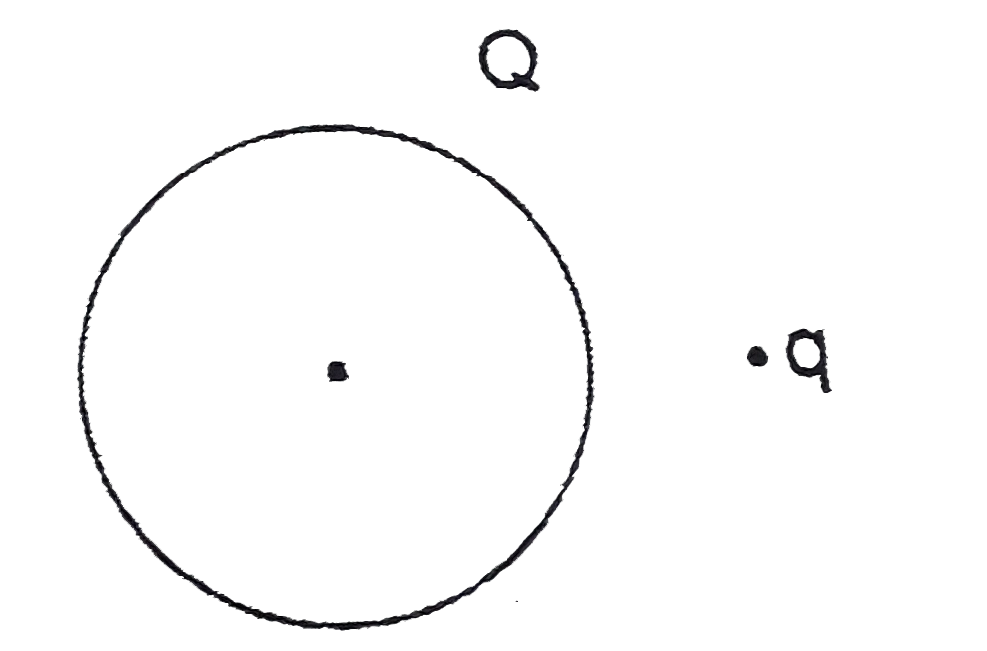State principle of superposition of charges and using it find an expression for force acting at a point charge due to assembly, of 'n' point charges.Solution in Punjabi
Principle of superposition of charges : According to this principle when a number of point charges interact in space then total force on a particular charge is the vector sum of forces exerted on it by all the other individual charges.
Consider that n point charges q1,q2,q3,........qn are distributed in space in a discrete manner. The charges are interacting with each other. Let us find the total force on charges say q1 due the all other remaining charges. If the charges q2,q3,......qn exert forces →F12,→F13,......→F1n on the charge q1, then, according to principle of uperposition, the total force on charge q1 given by
→F1=→F12+→F13+......→F1n ....(i)
If the distance between the charges q1andq2 is r12 , and ˆr21 is unit vector from charges q2andq2, then
→F12=14π∈0.q1q2r12ˆr21
Similarly, the force on charge q1 due to other charges is given by
→F13=14π∈0.q1q2r13ˆr31
...............
................
and →F1n=14π∈0.q1qnr21nˆrn1
Hence, in equation (i), setting the values of →F12,→F13,........→F1n the total force on charge q1 due to all other charges is given by
→F1=14π∈0(q1q2r212ˆr21+q1q3r213ˆr21+.....q1q2r21nˆrnt)
or →F1=14π∈0n∑i=1,j=1,in≠jqiqjr2ijˆrji

Topper's Solved these Questions
- ELECTRIC CHARGES AND ELECTROSTATIC FORCE BOOK - BETTER CHOICE PUBLICATIONCHAPTER - ELECTRIC CHARGES AND ELECTROSTATIC FORCE EXERCISE - NUMERICAL PROBLEMS
13 Videos
- ELECTRIC CHARGES AND ELECTROSTATIC FORCE BOOK - BETTER CHOICE PUBLICATIONCHAPTER - ELECTRIC CHARGES AND ELECTROSTATIC FORCE EXERCISE - NUMERICAL PROBLEMS (MOST EXPECTED NUMERICALS )
6 Videos
- ELECTRIC CHARGES AND ELECTROSTATIC FORCE BOOK - BETTER CHOICE PUBLICATIONCHAPTER - ELECTRIC CHARGES AND ELECTROSTATIC FORCE EXERCISE - SHORT ANSWERTYPE QUESTIONS (MOST EXPECTED QUESTIONS )
7 Videos
- DIPERSION OF LIGHTBOOK - BETTER CHOICE PUBLICATIONCHAPTER - DIPERSION OF LIGHTEXERCISE - MOST EXPECTED QUESTIONS
5 Videos
- ELECTRIC CURRENT, RESISTANCE AND E.M.F.BOOK - BETTER CHOICE PUBLICATIONCHAPTER - ELECTRIC CURRENT, RESISTANCE AND E.M.F.EXERCISE - MOST EXPECTED QUESTIONS
14 Videos
Similar Questions
How many electrons make up one Coulomb of charge ?
View SolutionDielectric constant of water is 80. What is its permittivity ?
View SolutionGive any four differences between mass and charge.
View SolutionWhat do you mean by dispersion of light?
View SolutionDefine SI unit of resistance.
View SolutionState superposition for electrostatic force on a charge due to a number of charges.
View SolutionFigure shows a uniformly charged sphere of radius R and total charge Q. A point charge q is situated outside the sphere at a distance r from centre of sphere. Find out the following :
(i) Force acting on the point charge q due to the sphere.
(ii) Force acting on the sphere due to the point charge.

View Solutionस्थिर - वैधुत में गौस के प्रमेय के बताइए । इसकी सहायता से दो बिन्दु आवेशों के बीच कार्य करने वाले बल के लिए व्यंजक प्राप्त कीजिए ।
View Solutionलघु बिंदु आवेश के कारण किसी बिंदु पर विभव के लिए व्यंजक ज्ञात कीजिए |
View SolutionState and explain the principle fo superposition as applied to electrostatic force on a charge due to a number of other charge.
View Solutionस्थिरवैधुत के अंतर्गत अध्यारोपण के सिद्धांत को लिखिए तथा किसी बिंदु आवेश पर n विविक्त बिंदु आवेशों डरा लगाये गये बल हेतु व्यंजक प्राप्त कीजिए।
View SolutionForce between two points in a medium | Force between multiple charges|Principle of superposition and illustraions on it | Introduction to electric field
View SolutionWhat is the imposition principle? How to use it to find Al at a point charge due to many charges?
View SolutionExplain the principle of superimposition and using it to derive the equation for the force exerted on a point charge due to a continuous charge collection.
View SolutionFind an expression for the potential at a point due to a point charge Q.
View SolutionState and explain the principle of superposition of interacting charges.
View Solution
